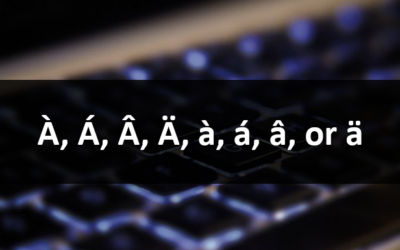Change the Format of a Number Field in a Microsoft Word Mail Merge Document Using Switches
by Avantix Learning Team | Updated January 16, 2021
Applies to: Microsoft® Word® 2010, 2013, 2016, 2019 and 365 (Windows)
You can change or fix the format of a number field in a Word mail merge document using switches in field codes. Number formatting issues typically occur when the source document for the mail merge is an Excel workbook or Access database. You can use switches to change the format of a number field to display currency symbols as well as commas or decimals.
A number field is typically inserted in the main document using Insert Merge Field on the Mailings tab in the Ribbon.
Related article: How to Use Mail Merge in Microsoft Word to Generate Form Letters
Do you want to learn more about Microsoft Word? Check out our virtual classroom or live classroom Word courses >
Using codes in a number field switch
The common codes used in a number switch are 0 for a required digit and # for a variable number. Codes entered in switches can contain multiple parts separated by semi-colons:
# = variable number
0 (zero) = required digit
The # code will be replaced by a digit only if it is not a leading or trailing zero. You can also enter commas (,), decimals (.) and currency signs ($). Since # specifies the minimum numeric places to display, if a place has no digit, it is replaced with a space.
Number switches start with \# and the codes that follow represent the format for the number. The merge codes may appear in quotes or double quotes.
The syntax of the full mail merge number field code with the switch is:
{MERGEFIELD FieldName \# number codes} or
{MERGEFIELD FieldName \# "number codes"}
If you want to include negative formatting, add a semi-colon after the first part. This follows the same logic as Excel custom number formatting. The first part formats positive numbers, the second part (after the semi-colon) formats negative numbers. If you add another semi-colon, this creates a third part that formats zero (0) values.
Quotation marks are not required for simple number formats that do not include spaces such as {Salary \# $#,##0.00}. For more complex number formats and those that include text or spaces, enclose the number format codes in quotation marks.
Changing the format of Word mail merge number field using a switch
To use a switch to change the format of a mail merge number field in Word, you will first need to display the field code and then type the switch starting with \#:
- In the main Word mail merge document, select the number field.
- Right-click the field and choose Toggle Field Codes from the drop-down menu to display the field code. You can also press Shift + F9 to display the field code.
- If necessary, delete \*MERGEFORMAT from the field code.
- Enter the switch after the field name (such as \# $#,##0). Be sure to type a space after \#.
- Right-click the field and choose Toggle Field Codes from the drop-down menu to hide the field code. You can also press Shift + F9 to hide the field code.
- Right-click in the field and select Update Field from the drop-down menu. You can also press F9 to update the field.
- Run the merge by selecting Edit Individual documents from the Mailings tab in the Ribbon and then click OK in the dialog box. In the merged document, the number should appear in the switch format.
Number field formatting examples
The following are examples of mail merge number fields formatted using switches. Number switches apply rounding by default.
To change the number field formatting to a format to display a dollar sign and insert a comma as a thousands separator, we used the following switch:
{MERGEFIELD Salary \# $#,##0}
To change the number field formatting to display a comma as a thousands separator and two decimal places, we used the following switch:
{MERGEFIELD SalesAmount \# #,##0.00}
To change the number field formatting to display a number under one thousand with two decimal places and a number of one thousand or more with a comma as a thousands separator, we used the following switch (the benefit of this switch is that Word will not include a space for missing digits):
{MERGEFIELD AmountOwing \# ,#.00}
The following switch could be used with negative numbers (if the original value was 1500.57 or -1500.57, this would display $1,500.57 for a positive number and ($1,500.57) for a negative number):
{MERGEFIELD AmountOwing \# "$,#.00;($,#.00)"}
The following switch is similar to the switch above but formats zeros as a dash (the dash is considered to be text so must be enclosed in single quotes):
{MERGEFIELD AmountOwing \# "$,#.00;($,#.00);'-'"}
Zero values can be suppressed by adding a final semicolon (;) in the switch but nothing after it. This suppresses zeros from empty fields and from fields containing zeros.
In the examples above, commas would be inserted only if the number was one thousand or more. The name of the number merge field in the above examples comes from the Excel source file. The curly brackets cannot be typed.
Subscribe to get more articles like this one
Did you find this article helpful? If you would like to receive new articles, join our email list.
More resources
How to Create a Table of Contents in Word
How to Insert a Watermark in Word (like DRAFT)
How to Remove Hard Returns in Word Documents
How to Find and Replace in Word (and use Wildcards)
How to Superscipt or Subscript in Word (with Shortcuts)
Related courses
Microsoft Word: Intermediate / Advanced
Microsoft Word: Designing Dynamic Word Documents Using Fields
Microsoft Word: Long Documents Master Class
Microsoft Word: Accessible Word Documents
Microsoft Excel: Intermediate / Advanced
Our instructor-led courses are delivered in virtual classroom format or at our downtown Toronto location at 18 King Street East, Suite 1400, Toronto, Ontario, Canada (some in-person classroom courses may also be delivered at an alternate downtown Toronto location). Contact us at info@avantixlearning.ca if you'd like to arrange custom instructor-led virtual classroom or onsite training on a date that's convenient for you.
Copyright 2024 Avantix® Learning
You may also like
How to Insert or Type I with an Accent Mark in Word (Í, í, Ì, ì, Î, î, Ï, or ï)
You can insert or type i with an accent mark in Word using built-in tools or keyboard shortcuts (including Alt code shortcuts). The letter i can be inserted with an accent in both upper or lower case. The following are common accented characters that you can insert or type in Word in upper or lower case: grave (Ì or ì), acute (Í or í), circumflex (Î or î) and umlaut (Ï or ï).
How to Insert or Type A with an Accent Mark in Word (À, Á, Â, Ä, à, á, â, or ä)
You can insert or type a with an accent mark in Word using built-in tools or keyboard shortcuts (including Alt code shortcuts). The letter a can be inserted with an accent in both upper or lower case. The following are common accented characters that you can insert or type in Word in upper or lower case: grave (À or à), acute (Á or á), circumflex (Â or â) and umlaut (Ä or ä).
10 Word Shortcuts to Select Text Using a Keyboard
You can use several shortcuts in Word to select text in your documents using only your keyboard. When you select text, it will typically be highlighted in grey. After you select text, you can cut, copy, or delete the selected text or apply character or paragraph formatting.
Microsoft, the Microsoft logo, Microsoft Office and related Microsoft applications and logos are registered trademarks of Microsoft Corporation in Canada, US and other countries. All other trademarks are the property of the registered owners.
Avantix Learning |18 King Street East, Suite 1400, Toronto, Ontario, Canada M5C 1C4 | Contact us at info@avantixlearning.ca








